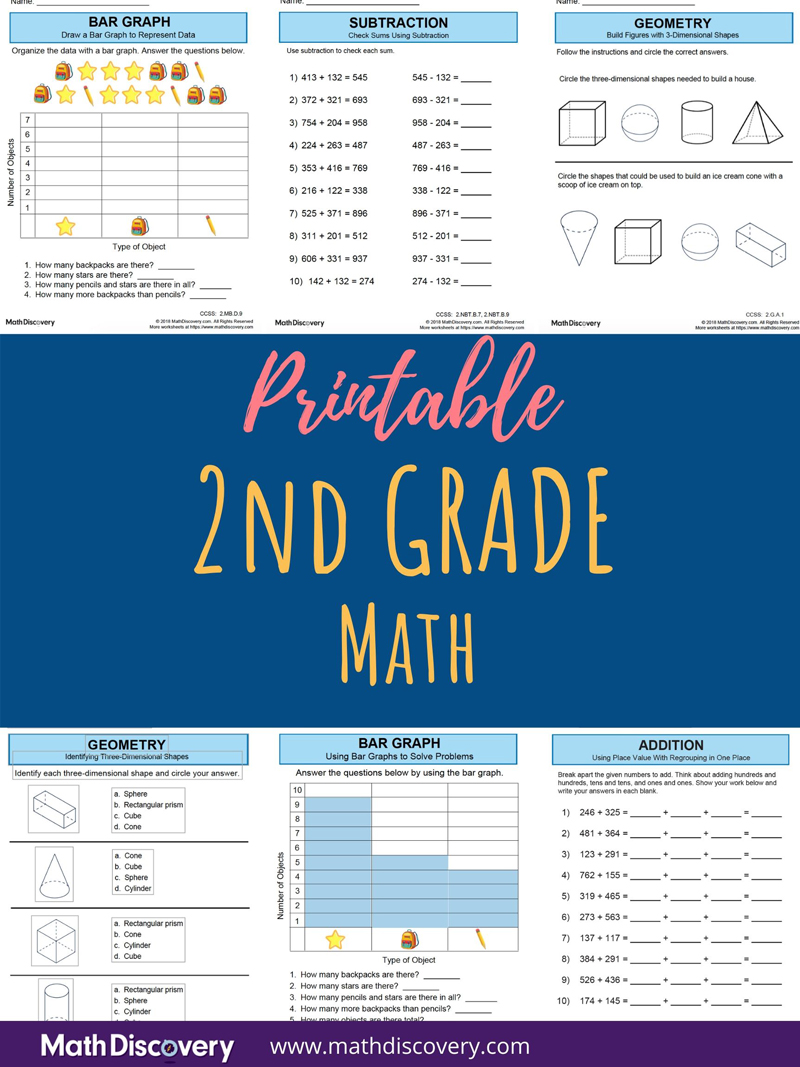2nd Grade Math

Introduction
The four key skill areas for Grade 2 students is place value, adding and subtracting two- and three-digit numbers, measuring length, and identifying characteristics of shapes. For the first two skill areas, it is helpful for students to use base-ten blocks. The worksheets picture them, but they will provide a better understanding for students if they can touch and move them. During this year, students will lay the foundation for place value understanding—recognizing that the value of a digit depends on its place in a number. Using base-ten blocks, students can see that 3 hundreds are very different from 3 ones.
Printable Lessons
2nd Grade Addition Worksheets
Students begin by reviewing basic facts. Make sure students have a good grasp of these facts before moving on to two-digit and three-digit addition. They will need to have the facts committed to memory by the end of the year, and working with base-ten blocks as they add greater numbers will help reinforce them. If you notice that students are still counting to add columns of greater numbers, spend more time with addition fact strategies so that students learn ways beyond counting to remember the facts.
2nd Grade Subtraction Worksheets
Students will follow the same progression of skills learning to subtract greater numbers as they did when learning to add. The mastery of subtraction facts should be a little easier to attain if students remember that they can use addition facts to help them. Students learn to regroup when adding greater numbers, but, in general, students find it more challenging to work backward in the regrouping process when subtracting. To help transition from blocks to symbols, after using blocks to subtract have students record the subtraction symbolically—noting regrouping clearly above columns. Students will begin these worksheets with basic fact review, such as subtracting using doubles, using a ten, and relating subtraction and addition. Then, they will move on to fluently subtracting within 10, fluently subtracting within 100, subtracting within 1000, and mental subtraction. This will include skills, such as subtracting using place value, using base-ten blocks, breaking apart tens and hundreds, regrouping, and more.
2nd Grade Geometry Worksheets
Students continue their exploration of shapes by counting specific features—sides, angles, and faces. It is simple to count sides and angles in drawings of two-dimensional shapes. It can be more challenging for students to identify faces of three-dimensional shapes in a drawing. Use real objects to help students count faces. For example, you can use a cereal box for a rectangular prism, a die for a cube, a can for a cylinder, and an ice cream cone for a cone. Students also continue to use shapes as a model for fractions. It is important that students identify equal parts of a shape as a basis for fraction sense. In your everyday language, watch how you use fraction words such as “half”. Students should begin to recognize that there cannot be a “larger half” since halves of the same object are the exactly the same size.
2nd Grade Multiplication Worksheets
These 2nd-grade multiplication worksheets will help your students learn the foundations of multiplication in order to get ready for 3rd grade. They will start by learning to determine whether a number is even or odd by pairing objects and counting by 2s. Then, students will place objects in equal groups and find the total number by using repeated addition. This reinforces the addition skills students are learning while also setting the stage for multiplication—one of the key focus areas for Grade 3. They will learn to write and solve addition equations in order to show that they understand repeated addition.
2nd Grade Graphing and Charts (Data)
Students represent data on different graphs—picture graph and bar graph—and use these graphs to answer simple questions that require addition or subtraction to solve. While using these worksheets, you can assess students’ mastery of basic facts and their general understanding of addition and subtraction.
2nd Grade Place Value Worksheets
All of our computations rely on an understanding that the value of a digit depends on the place it is in. Working with base-ten blocks and identifying the value of each digit in a number helps to develop that understanding. Students work with numbers up to 1000. They name, model, count, and compare them.
